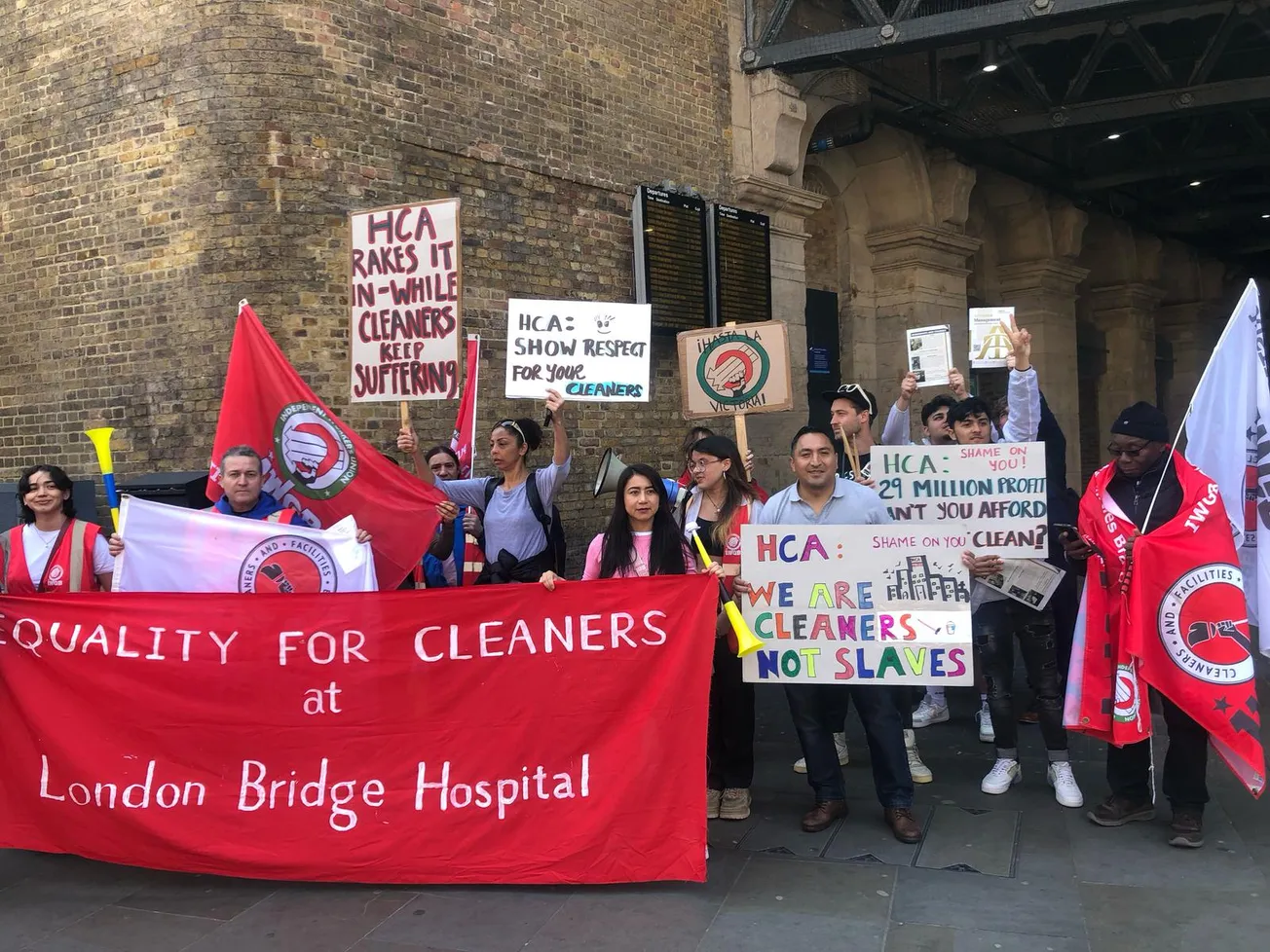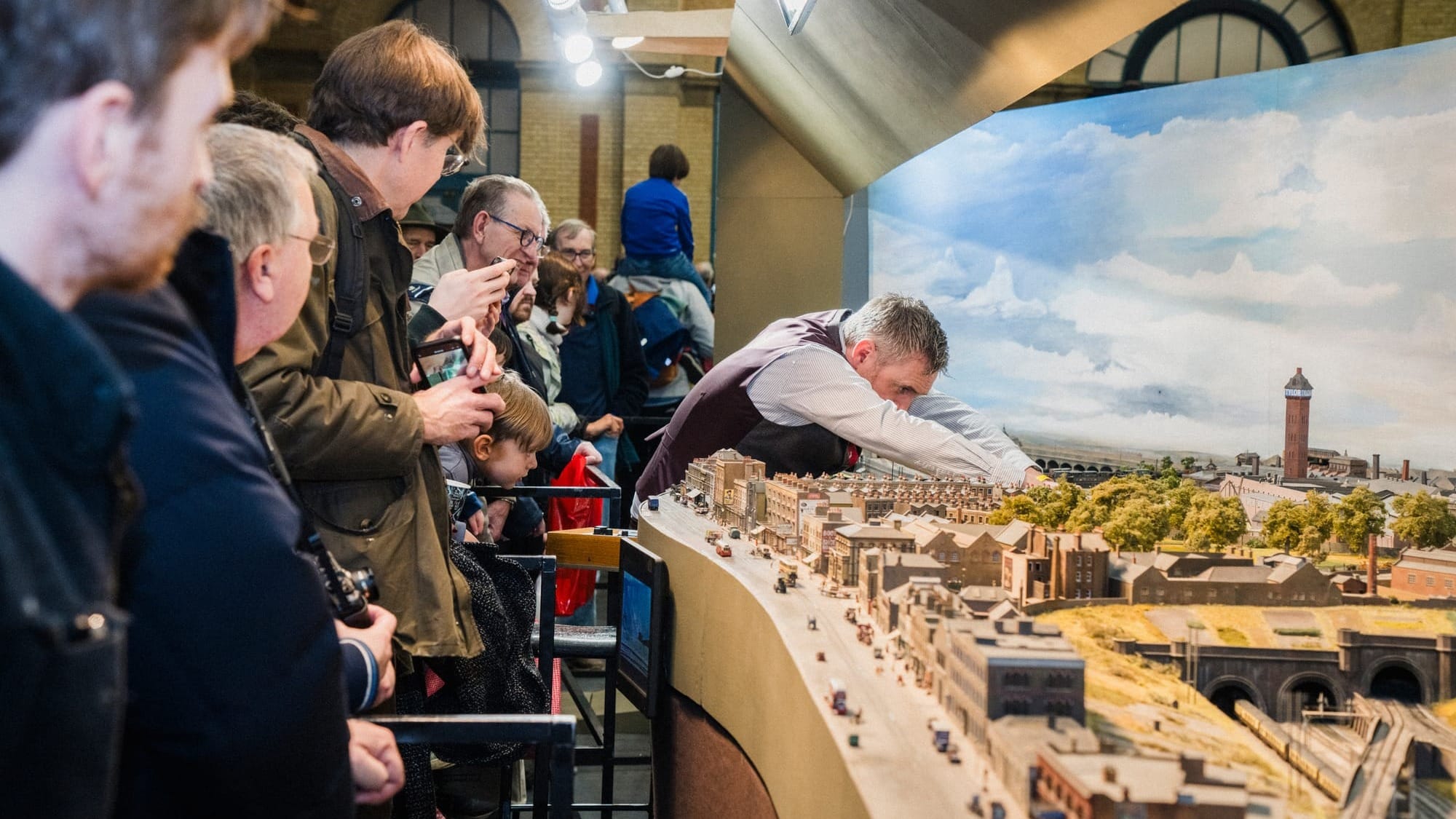Flat-capped, hands in pockets, he waits for a train that will never come. Down the street from the station, a blue-coated postman stands frozen in conversation. The washing that hangs behind him, strung across the backs of the houses, will remain there forever. No matter; it’s not going to rain.
For Terry Tew, now semi-retired from a career in construction, this scene — an expansive diorama of an imagined London — has been the work of 20 patient years. He calls it Rossiter Rise; a fictional slice of the city located “somewhere in northwest London in the mid-late 1950s”. Its fabrication, Terry explains, relies on childhood memories of the London he grew up in. Its station building is based on Belmont and Primrose Hill, while its underground depot is inspired by Drayton Park; all boasting “very typical London underground fitting and signage”. There are rows of townhouses, stores, gas lamps, pedestrians, workshops and even a newfangled brutalist tower block. It’s a whole, living world.
From his home in Oxfordshire, Terry refers to Rossiter as “a stage, or a piece of theatre”. Looking closely, you can’t help but animate the model with stories and chatter. “I’m trying to create something that people can believe in — or escape into,” Terry explains. I find myself doing both, peering at a vision of London that my grandparents, born and bred in the city, would have felt quite at home in.
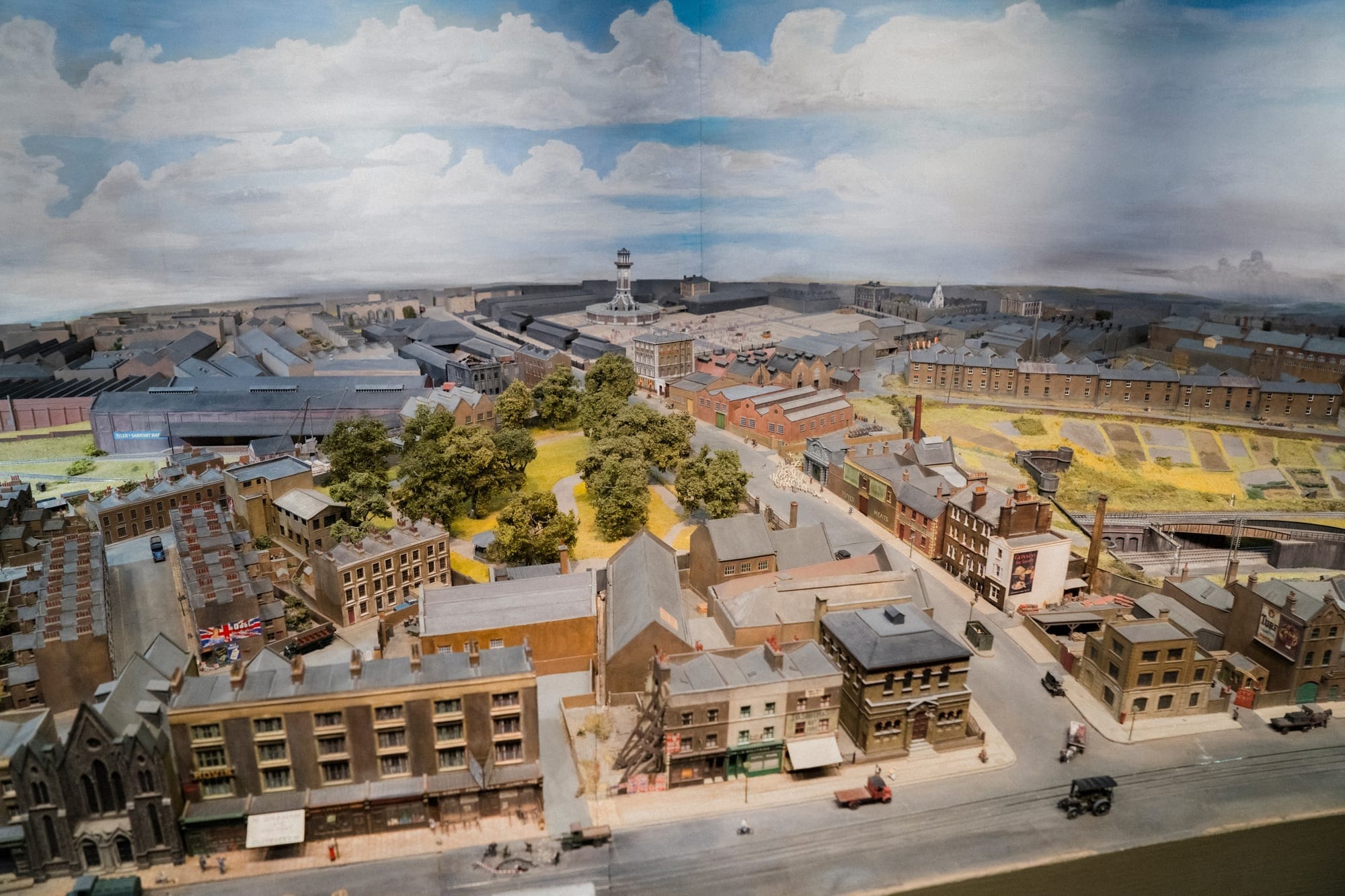
The world of London’s scale modellers might — from its delicately hand-painted exterior — seem small indeed; a particularly niche interest, attracting only the most modest of followings. But the capital, with its tangled, messy, patchwork history, turns out to be a popular subject for models, dioramas and replicas, a huge number of which focus on its transport infrastructure. This is hardly surprising: London has the world’s oldest underground system, and much of the city’s sprawl can be chalked down to the explosion of commuter rail. In many ways, the story of London has been defined by its railways, bus lines and underground stations — and the roundels, tube maps and liveries that come with them.
Browsing Facebook, it appears that modellers and collectors would agree. I’m met with a thicket of busily populated groups, each filled with diecast Routemaster buses bearing adverts for Premium Bonds, Bisto and Jacob’s Cream Crackers; black cabs; suburban rail lines and dinky bus garages, the majority of which look fondly to the past. In my research, I spot only a handful of contemporary models. In comparison to their colourful and stylish forebears, they seem a little drab to my eye.
“I think nostalgia for your own youth plays a big part in what era people decide to model,” explains Ashley, a modeller I meet through Facebook. Having left London for Sweden in 2012, Ashley tells me that he started his own London model — builders tend to focus on one model at a time — after realising that what he missed the most from “home” was the passing trains. Now, he finds himself re-creating that home in miniature. Like Terry, Ashley is looking to his youth, assembling a model “that represents a generic Network Southeast region railway set in the early 1990s”. His desire to create a London model was nudged by nostalgia: “The underground and southeast trains were a part of my everyday life”, he says. “I have fond memories of my brother and me trying to attract the train drivers’ attention to get them to sound their whistle or horn.” Facsimiles of long-retired D78 District Line trains will run on his model, once it’s fully assembled.
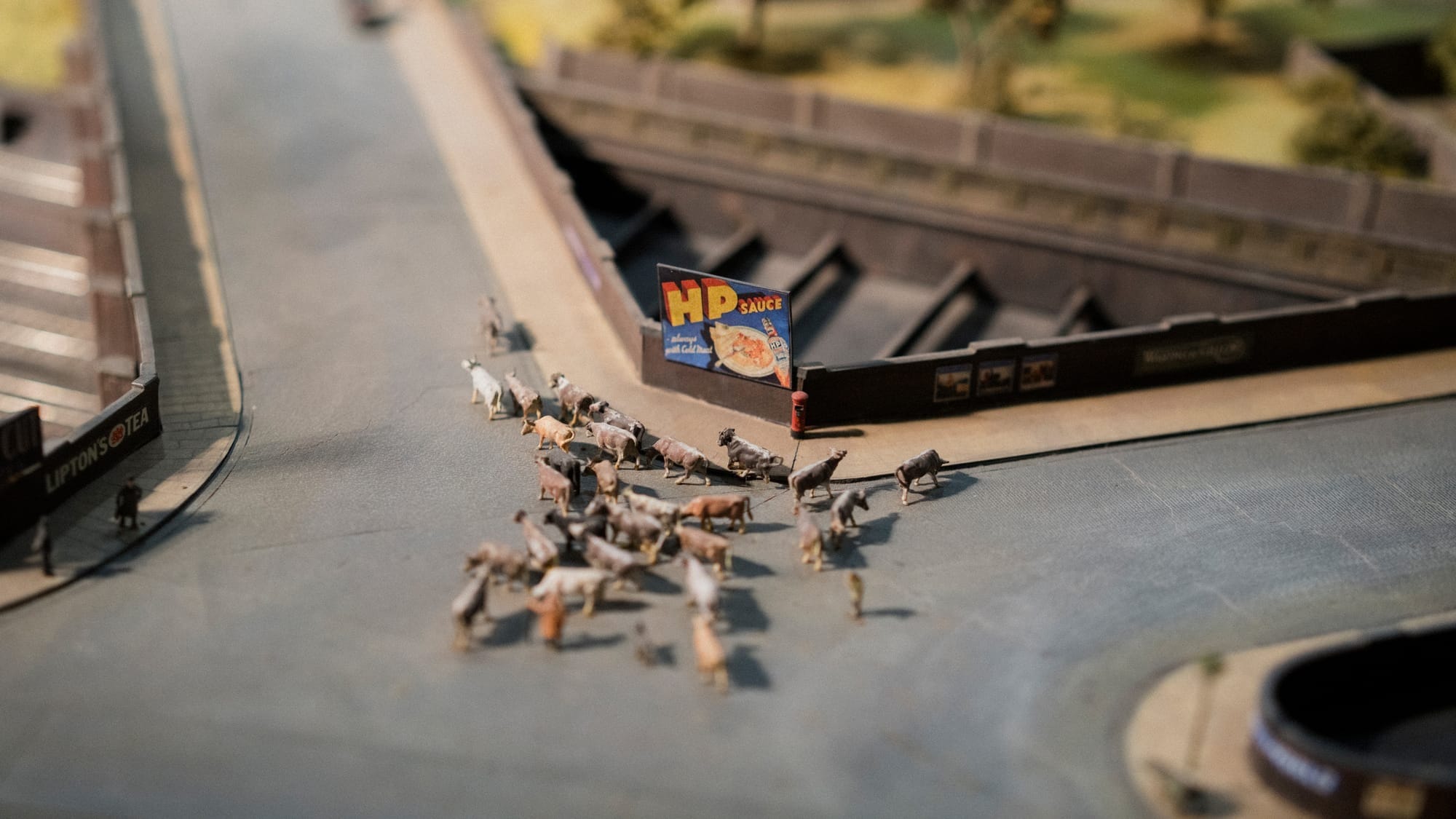
There’s a certain hopeful melancholy about these endeavours, I realise; as if by creating a scale replica you are, at least in miniature, holding on to a past that might otherwise fade. By way of a point, Ashley’s model will feature a recreation of the house that he grew up in, which is slated to be demolished at the end of the year. “My home will be gone forever,” he muses, “and will only exist in a few photos, and my model”. While you can’t stop a wrecking ball, you can create something so small that it might escape its swing.
Understandably, a city as patchworked and old as London prompts a wide assortment of approaches among its modellers. Where some strive for rigorous levels of authenticity, others use the ‘real’ London as a springboard, making artful adjustments for era and taste, so that the image of the city that emerges from this cloistered labour of cardboard, plastic, paint and glue seems suspended between real life and an impressionistic daydream. It’s these departures from reality — combined with fastidious attention to period detail — that could be considered the hallmark of London modelling. On a bright, springtime Sunday, Tim Watson, the affable president of the Model Railway Club (MRC) and a professor of dentistry at Guy’s Hospital, gives me a tour of the club’s Copenhagen Fields. Set sometime in the 1930s, construction began on this sprawling diorama of a semi-fictional area north of King’s Cross in 1984.
In the club’s workshop off Pentonville Road, piled high with boxes, craft supplies, plywood, tools and disarticulated sections of rail, I stoop to study a collection of tiny public lavatories. The model’s fabricators have been crafting this kind of street life over the decades: bollards, postboxes, omnibuses, briefcase-wielding gents, rows upon rows of houses and even a sombre horse-drawn hearse. When I ask about the seemingly random assortment of shops and businesses dotted around the model, Tim explains that these belong to the club’s members; pointing out his ‘own’ dental surgery, with a handsome black exterior, on Caledonian Road. Elsewhere, his grandchildren’s names adorn signage above a row of warehouses.
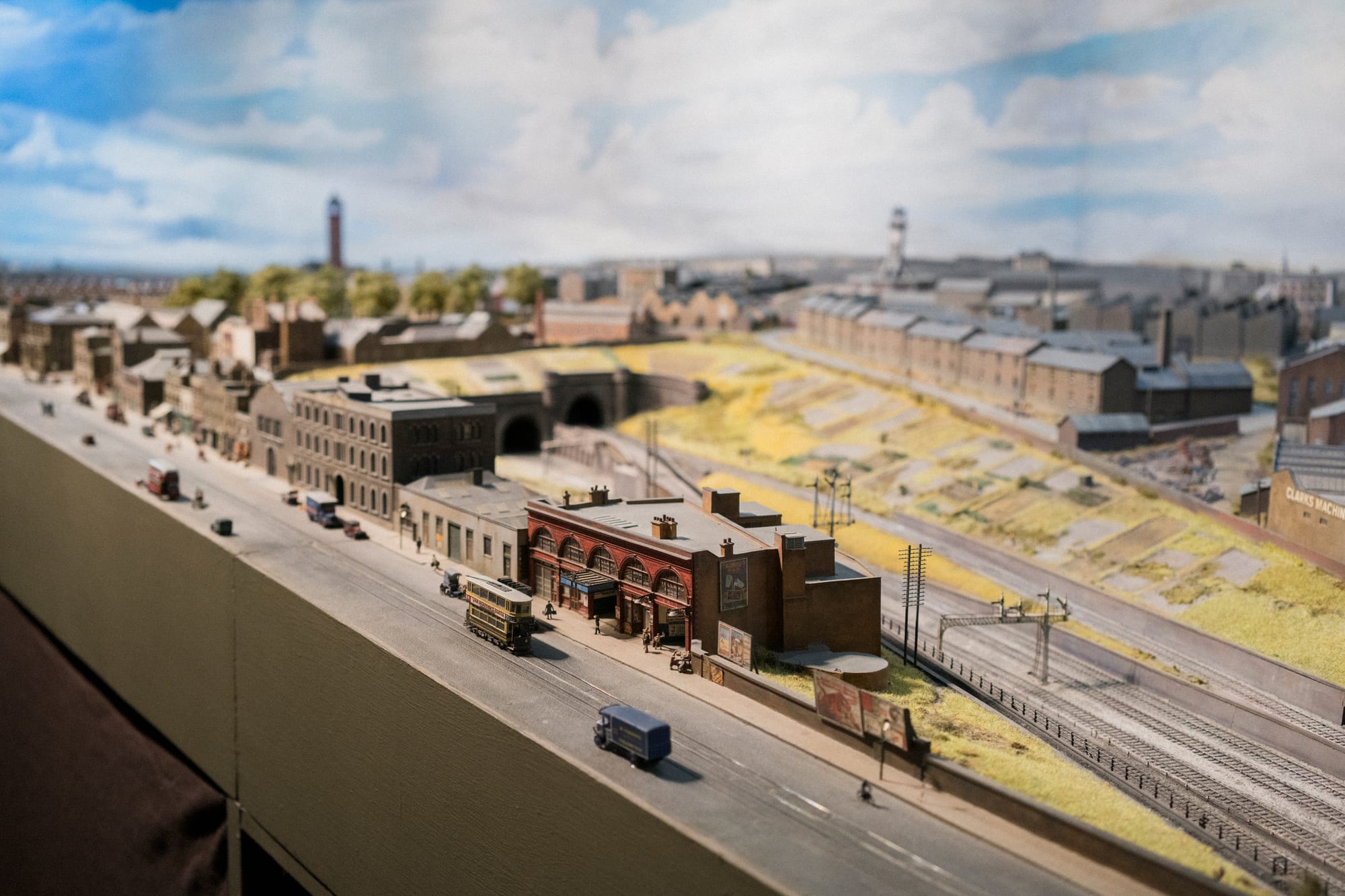
Pulling out his phone, Tim draws attention to the reference materials club members have used to build Copenhagen Fields, including pre-war aerial photographs which capture the city in extraordinary detail. In days past, the modellers had to go to an archive in Elstree to study physical documents. Today, the internet has made the research easier, just as 3D printing has allowed for ever finer levels of detail. Still, it requires impressive amounts of patience and skill. 3D-printed features “need to be weathered and painted”, Tim says, like adding tiny slate tiles, minuscule hedges, plant pots and individual bricks. Most impressive of all is a shop window with a display of leather cases, each of which has a microscopic price tag attached.
For the model’s fabricators, the decision to depart from London’s architectural reality is down to a mixture of aesthetics and practicality. Roads and bridges have been relocated to accommodate the layout’s outer limits; certain tunnels have been left out, as Tim observes, simply because it’s “not very interesting” to look at a tunnel. I concede that this sounds fair. “It’s a little bit elastic,” he explains. Carole, the club’s deputy chairman, likens the work to painting a portrait, and they both agree that the aim is for the model to be “recognisably London”, albeit inflected with the personalities, preferences and in-jokes of the people who’ve built it. Tim remarks that the tough part of modelling is “knowing what to leave out — and what to put in”.
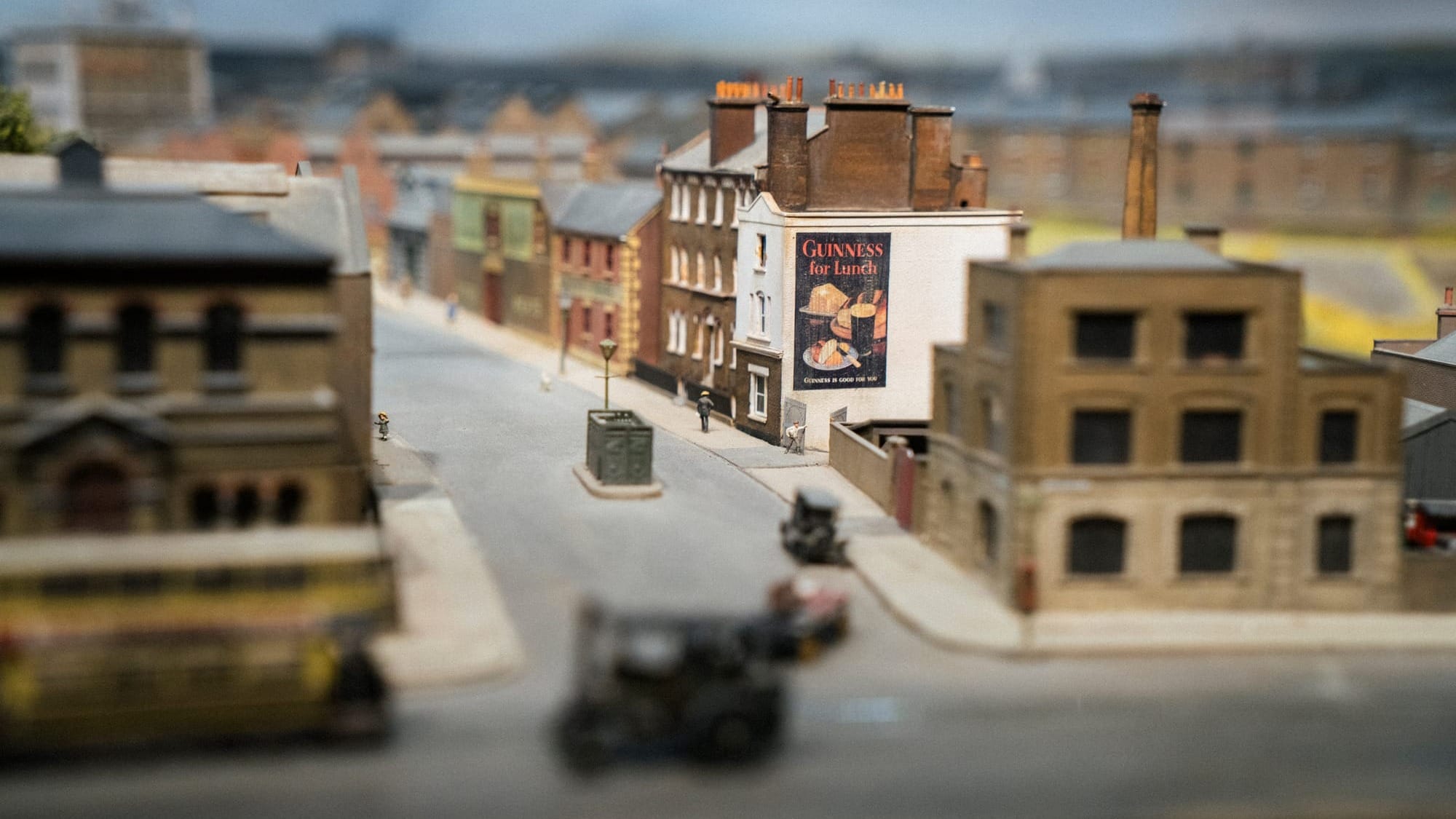
From an outsider’s perspective, it seems like nothing is too small to be included. Peering closely, I spot weathered walls plastered with tiny adverts for Oxo, Lyons, Lipton and Guinness. There are even the public toilets of the (now closed) York Road underground station, which also features a fully working lift. Eventually, Tim points out the club’s own 1960 building, a rare intrusion of the ‘modern’ into an otherwise historic scene. To emphasise the point, Tim beckons me to step through a fire door. Outside, the wall — much older than the building the club uses — is slaked in waterproof tar left over from the second world war, when the space was used to store water for the fire service. There are remnants of the past everywhere, if you know where to look.
During my tour, Tim also draws attention to the Copenhagen Fields’ unexpected Easter eggs. Pride of place is given to the house of Mrs Wilberforce, the eccentric widow whose home plays a starring role in the 1955 Ealing comedy The Ladykillers. He points out a diminutive film crew, before drawing attention to Mrs Wilberforce herself, standing proudly at her front door. The house, which Tim plucks gingerly from the street, sits on top of a rectangular excavation filled with chariot wheels and bones. “It’s an archaeological dig of Boudica’s grave,” he explains, demonstrating a scholarly attentiveness to London’s long, layered and often volatile history. The ethos is a little bit of fact, a little bit of fiction: down the street, there’s the pub where The Ladykillers’ cast and crew, including Alec Guinness and Peter Sellers, would get their pints in after the day’s filming was done.

Perhaps the biggest departure from reality I experience when looking at the model is its overall cleanliness. Despite representing a city that has become historically synonymous with smog and grime, it’s spotless. This seems particularly strange when it comes to places like King’s Cross; as the terminus where the coal that fed the city was brought in, it would have been a particularly polluted place back in the 1930s. But the club’s modellers prefer a spruced-up vision of the city, and so, fittingly, the trains that run along its tracks are electric, bringing this 40-year-old model squarely into the new millennium.
Soon, Copenhagen Fields will be packed up and transported to Alexandra Palace for the London Festival of Railway Modelling, an annual event which, I’m assured, is the model scene’s hottest ticket. Making my way to the packed halls of Ally Pally, which one attendee confesses they travel “religiously” to, I find myself talking to Dawn Quest, a modeller and YouTuber whose interest lies in layouts inspired by films. With an attentive crowd gathered around her stall, Dawn gives me an enthusiastic tour of her own model of London as it appears in The Ladykillers — unlike the MRC’s version, Dawn’s layout is true to the film’s fictional version of London, having “squished together” various sets so that they can be appreciated from a single angle. Naturally, Mrs Wilberforce’s house takes centre stage. The whole thing isn’t much wider than a suitcase, eschewing width in favour of compact verticality.

Leaving Dawn’s London behind — and passing by the now fully articulated Copenhagen Fields, which attracts a dense scrum of observers — I’m reminded of something Carole mentioned at the Club: the hobby is “a very small world”, even if the heaving crowds at Alexandra Palace suggest otherwise. But within the throng there is a tight community that, despite its air of solitary quietude, flourishes through conversation and collaboration. Everybody knows everything, and everyone.
It’s during a second visit to the MRC, some weeks later, that I get to see this in practice. I join Peter, George, and Paul as they work on an under-construction model of Bow Junction, this time set in 1910, the year of the club’s founding. Unlike Copenhagen Fields, this layout is very much a construction site, with MDF, glue and wires poking out between freshly laid tracks. Over the sound of sawing and deliberation about measurements and gauges, Peter, a retired civil engineer and project lead for Bow Junction, uses language I’ve become familiar with. “It’s like a stage, really,” he says, our bodies facing the shell of Bow Junction’s train workshop. “Imagine you’re in the theatre; it’s like sitting in the audience.” For all the fastidious, labour-intensive work of wiring, electrics, painting and research, the endeavour is ultimately a spectacle, designed to be displayed and seen.
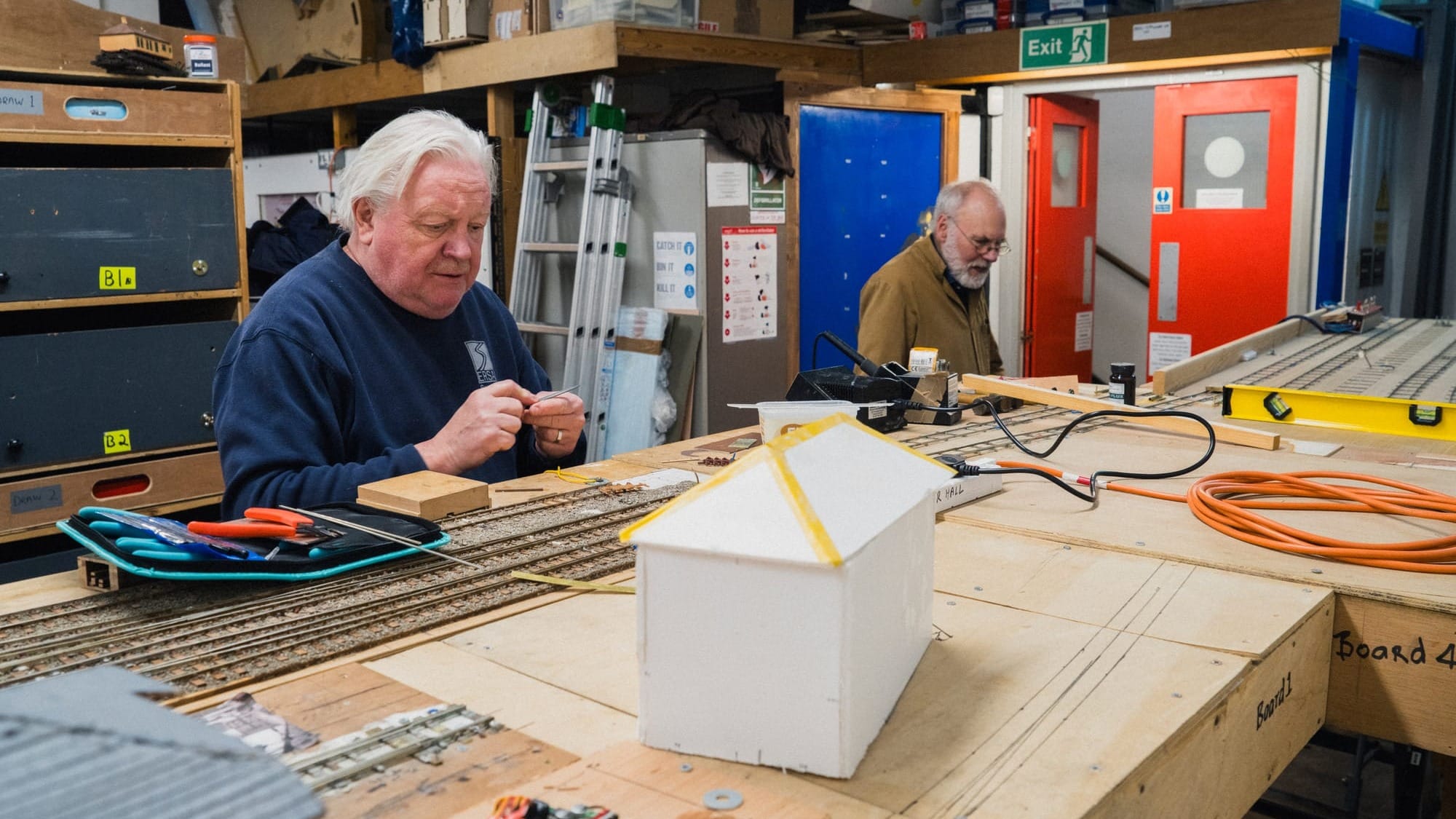
What’s most interesting about London’s miniature replicas, I come to realise, is how each hobbyist brings their own personality to the modelling table. Unlike the real London, there’s no top-down urban plan. You can create the city as you want it to be. What’s more, the group layouts take so long — decades, in some instances — that there’s always space for digressions and diversions. The result is a reflection of a city that, despite its monolithic brand, escapes easy codification. The old-style Routemaster and D78 might now be museum pieces, but artefacts of London’s past continue to make their way along shelves in suburban garages and over trestle tables in Zone 4 workshops, still bearing adverts for Jacob’s cream crackers and West End shows that have long since seen their final curtain. If the bustling crowds who made their way to Alexandra Palace are anything to go by, modelling could go on forever, even if the city itself continues to change beyond recognition.
During a busy evening in the club’s social space, Tony Cox, chairman of the MRC, mentions the club’s growing youth membership. For these youngsters, steam and diesel might seem a little “old hat”. Little by little, London’s transport — by way of the Elizabeth Line, fancy new rolling stock and long-awaited extensions to the Bakerloo — is modernising. I imagine that the models, and their builders, will gamely follow suit.
Thanks for reading today's story. You can now become a paying member of The Londoner, giving you access to all of our members-only stories. We're running a 20% early-bird discount on memberships. Click here to get an annual membership for the discounted price of £71.20, or click here to get a monthly membership, discounted to £7.16 a month for your first six months. Thanks for your support.

Comments
How to comment:
If you are already a member,
click here to sign in
and leave a comment.
If you aren't a member,
sign up here
to be able to leave a comment.
To add your photo, click here to create a profile on Gravatar.


